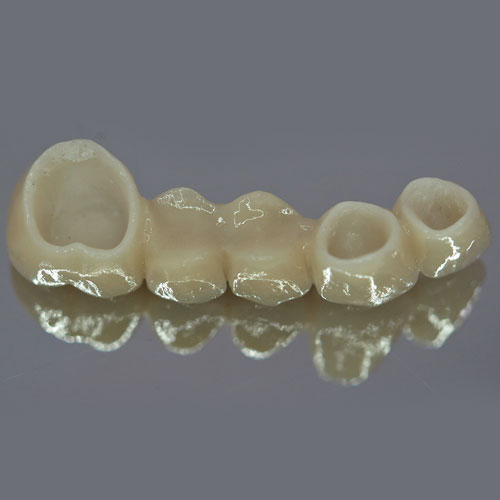SUPERIOR AESTHETICS
Higher aesthetics compared to a conventional metal-ceramic bridge
Good oral hygiene habits, daily brushing and flossing guarantee the long-term maintenance of ceramic bridges and their problem-free function.

A bridge is placed when a gap – formed by a missing tooth – needs to be restored for aesthetic or functional reasons. Like conventional porcelain-fused-to-metal bridges, all-ceramic and zirconium bridges consist of at least two crowns, which are placed in neighboring teeth and hold the bridging over the gap. When more than one tooth is lost, then a bridge becomes more complex. There is no standard size of bridge or number of crowns needed, as it depends on the number of missing teeth and the number and position of teeth kept in the mouth. Therefore, the design of each bridge is unique.
Restoring missing front teeth, apart from dealing with the aesthetic appearance of the smile and of the face as a whole, it keeps adjacent teeth in place and prevents misalignment, crowding or gap formation and improves speech. An all-ceramic or zirconium bridge are excellent choices when aesthetics matters because of the absence of the metal frame that is used in a conventional metal-ceramic bridge resulting in discoloration at the gingival margins. An all ceramic crown gives transparency, better absorption of light through incremental layers of porcelain and a natural look. An all-ceramic bridge can be placed when 1-2 front teeth are missing, but in cases of gaps at the posterior region, or when more than 3 teeth are missing and the bridging is extended, zirconium offers that extra strength needed. Placing an all-ceramic bridge restores the smile after a traumatic injury and costs less than placing an implant. Metal-free bridges are also the treatment of choice for congenitally missing teeth, when a gap should be restored immediately after an extraction and when restored teeth should blend in with the natural teeth and not make a restoration seem fake. When teeth are extremely damaged due to caries or trauma, a root canal treatment may be needed. Aesthetic bridges can be combined with crowns or porcelain veneers for a total smile makeover, both in upper and lower teeth.
The process followed resembles that of ceramic crowns, with the difference that visits may last longer when more teeth need to be treated. Usually for a simple 3-unit bridge, for combined crowning and bridging on 4-5 teeth, or for a full front-teeth bridge, either all-ceramic or zirconium, 3 dental visits are needed. Like all-ceramic crowns, the bridge consists of porcelain frame covered with transparent ceramic. Teeth are prepared according to the treatment plan, impressions are made and sent to the laboratory where a specialized ceramist will manufacture the prosthetic restorations. Zirconium bridges are digitally manufactured and milled to the appropriate size and shape in order to match the prepared teeth. In the meantime, provisionals are placed in order to protect teeth and provide a nice appearance. Try-in of the ceramic or zirconium substructure follows and the bridge is bonded at the next visit with aesthetic resins in order to match exactly the tooth color.


